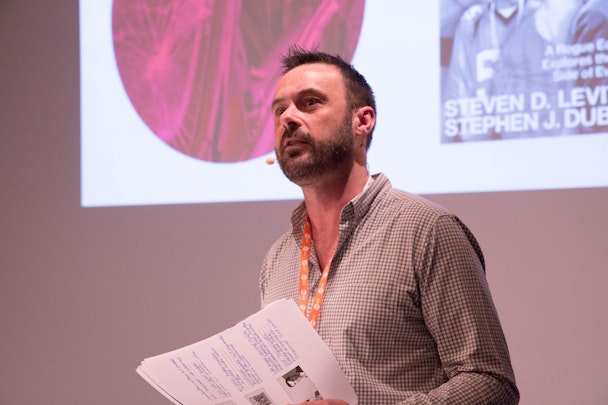Is strategy becoming an end rather than the means?
The relationship between strategy and creativity seemed like such a good idea for a Eurobest talk. Little did I realise the sleepless nights that would follow! The question hanging in the balance is centered around whether more and more sophisticated strategy always translates to an increase in creativity?

John Clark on stage at Eurobest
Obviously great strategy can certainly help. You need only look at, say, APG Award winners to see that. But we’ve all been witness to weeks and months of ‘strategising’ without a corresponding award winner in sight. So simply more strategy is no guarantee of brilliance.
And in examining ‘more sophisticated’ understanding, I have to confess to liking a good battle of opposing theories.
So the story of NYC police building a policing strategy on ‘broken windows theory’ became more interesting when, in ‘Freakonomics’, it was argued that it wasn’t responsible for the drop in crime and that other factors such as increases in police numbers were more likely to be the drivers.
And I loved Malcolm Gladwell’s theory of The Tipping Point to explain how trends caught on. But loved even more Duncan Watts’ rebuff that trends have more to do with accurately judging the public’s mood than targeting a few ‘influentials’.
Even when best practice is established is it always a good thing? Jim Carroll often writes on wind-tunnel marketing (the effect where all cars being put through wind tunnels to increase efficiency has the side effect of making them blander) happening in communications too.
So if the experts can’t agree, how the hell are we to understand? Well, how about a fantastically argued talk by Nick Southgate who, as you might expect from a trained philosopher turned strategist, argues that effectively the answer is within us if we just hone our empathy skills.
Or Gary Duckworth, writing many years ago, that we let the language ‘67 per cent persuasion indexes’ provide the illusion of precision, at the expense of the language of humanity, at our peril.
Or James Webb Young’s ‘A Technique for Producing Ideas’ published in 1940, which effectively boils down into: read into your issue, have a lot of interests unrelated to your issue, think on it then put it aside, do something else and let your mind wander and subconscious take over – and ideas will come.
So how does all this resolve? Five years ago I switched from the world of advertising to the world of design; in many ways strategically similar, but in two ways very different. Firstly, the output is more visual, less wordy (no copy, headlines, narrative or v/o) so soft skills play a greater role. Secondly smaller budgets mean less time to do things including strategy. But quicker doesn’t mean any less good brand thinking happening.
To address all this they’d developed range of strategic techniques that combined traditional rigour with design thinking, intuitive and projective techniques. And it worked – in fact so well that a client challenged us to find out why, guessing there was more to it than ‘they use visuals in strategy because they’re a design agency’.
Which led, via lots of books, articles and some smart young neuroscientists to the world of System 1 and 2 thinking. And the realisation that, when you think about it, a lot of strategy is inherently System 2, conscious, debating, evaluative, but not much like System 1. Which is maybe why, strategically, things can ‘look good on paper’ (System 2) but don’t always work in the System 1 dominated real world.
Moreover, it may explain a lot of my passions and misgivings, from the need for leaps of faith to the trouble with ‘logical’ analysis, to the power of ‘empathy’, to James Webb Young’s technique for having ideas (letting System 1 getting a word in edge ways?).
Knowing that if good strategy requires understanding human decision-making, choices and behaviour – and that that has System 1 at the heart of it – then whilst strategic ‘rigour’ is all very well, perhaps we need to let System 1 get a look in. We should celebrate soft skills such as empathy and intuition (as well as logic and reason), and certainly not think them ‘un-strategic’.
Ultimately, like salt, used in the right way – and sparingly – strategy can enhance, connect and bring out creative magic that leads to success. But it’s the means, not the end, and too much, or the wrong sort, can very well spoil the dish.
John Clark is planning director at Coley Porter Bell
